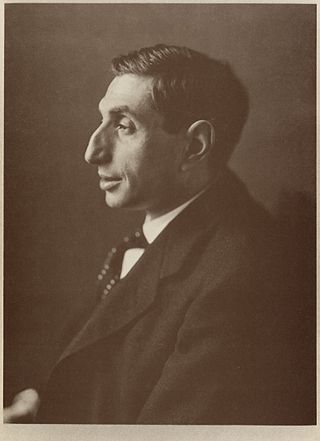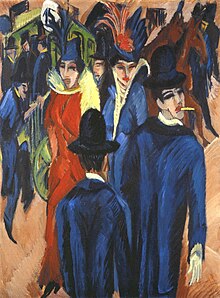
Emil Nolde was a German-Danish painter and printmaker. He was one of the first Expressionists, a member of Die Brücke, and was one of the first oil painting and watercolor painters of the early 20th century to explore color. He is known for his brushwork and expressive choice of colors. Golden yellows and deep reds appear frequently in his work, giving a luminous quality to otherwise somber tones. His watercolors include vivid, brooding storm-scapes and brilliant florals.

Egon Leo Adolf Ludwig Schiele was an Austrian Expressionist painter. His work is noted for its intensity and its raw sexuality, and for the many self-portraits the artist produced, including nude self-portraits. The twisted body shapes and the expressive line that characterize Schiele's paintings and drawings mark the artist as an early exponent of Expressionism. Gustav Klimt, a figurative painter of the early 20th century, was a mentor to Schiele.

Degenerate art was a term adopted in the 1920s by the Nazi Party in Germany to describe modern art. During the dictatorship of Adolf Hitler, German modernist art, including many works of internationally renowned artists, was removed from state-owned museums and banned in Nazi Germany on the grounds that such art was an "insult to German feeling", un-German, Freemasonic, Jewish, or Communist in nature. Those identified as degenerate artists were subjected to sanctions that included being dismissed from teaching positions, being forbidden to exhibit or to sell their art, and in some cases being forbidden to produce art.

Ernst Ludwig Kirchner was a German expressionist painter and printmaker and one of the founders of the artists group Die Brücke or "The Bridge", a key group leading to the foundation of Expressionism in 20th-century art. He volunteered for army service in the First World War, but soon suffered a breakdown and was discharged. His work was branded as "degenerate" by the Nazis in 1933, and in 1937 more than 600 of his works were sold or destroyed.

The Neue Galerie New York is a museum of early twentieth-century German and Austrian art and design located in the William Starr Miller House at 86th Street and Fifth Avenue in New York City. Established in 2001, it is one of the most recent additions to New York City's famed Museum Mile, which runs from 83rd to 105th streets on Fifth Avenue in the Upper East Side of Manhattan.

Otto Müller was a German painter and printmaker of the Die Brücke expressionist movement.

Karl Schmidt-Rottluff was a German expressionist painter and printmaker; he was one of the four founders of the artist group Die Brücke.

Karl Christian Ludwig Hofer or Carl Hofer was a German expressionist painter. He was director of the Berlin Academy of Fine Arts.

Walter Gramatté was a German expressionist painter who specialized in magic realism. He worked in Berlin, Hamburg, Hiddensee and Barcelona. He often painted with a mystical view of nature. Many of his works were inspired by his experiences in the First World War and his illness.

Alfred Flechtheim was a German Jewish art dealer, art collector, journalist and publisher persecuted by the Nazis.

Berlin Street Scene is a 1913 painting from the cycle Street scenes, by the German expressionist artist Ernst Ludwig Kirchner. The cycle, created by Kirchner between 1913 and 1915, often depicts "Kokotten" (prostitutes) with their clients, and is regarded as one of the most important works of German Expressionism.

Alfred Hess was a German Jewish industrialist and art collector.
Jill Lloyd is a writer and curator specializing in twentieth-century art, with particular expertise for German and Austrian art. She has organised many critically acclaimed exhibitions for leading museums and has published widely, including her book German Expressionism, Primitivism and Modernity, which was awarded the first National Art Book Prize.
Galerie St. Etienne is a New York art gallery specializing in Austrian and German Expressionism, established in Vienna in 1939 by Otto Kallir. In 1923, Kallir founded the Neue Galerie in Vienna. Forced to leave Austria after the 1938 Nazi invasion, Kallir established his gallery in Paris as the Galerie St. Etienne, named after the Neue Galerie's location near Vienna's Cathedral of St. Stephen. In 1939, Kallir and his family left France for the United States, moving the Galerie St. Etienne to New York City. The gallery still exists, run by Otto Kallir's granddaughter Jane at 24 West 57th Street.
Rudolph J. Heinemann, also known as Rudolf J. Heinemann, was a German-born American art dealer and collector of Old Masters. He was an advisor to Baron Hans Heinrich Thyssen-Bornemisza, who established a museum in Lugano, Switzerland with his help. Heinemann and later, his wife Lore, donated works of art to the Metropolitan Museum of Art, the Frick Collection, the National Gallery of Art and the Morgan Library & Museum.
The Galerie Nierendorf is a commercial art gallery based in Berlin founded by Karl and Josef Nierendorf in 1920, and reopened in 1955 as the Galerie Meta Nierendorf by Florian and Inga Karsch.
Serge Sabarsky was an art collector and art dealer of the 20th century.
Alexander Vömel, or Voemel, was a German gallery owner and Nazi party member who took over the gallery of the Jewish art dealer Alfred Flechtheim when it was Aryanized in 1933.
Valerie Vally Eisler was an Austrian Jewish art collector who was robbed and murdered by Nazis in the Holocaust.













